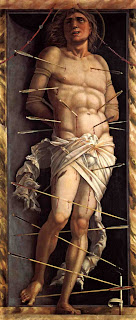The Power of Visuals
Who is this
man? Where is he? What’s he feeling why?
Did you
search for descriptive words? Did you think of situations occurring in the
world today, like the refugee crisis in Europe? Did your feel for the man?
Images are incredible effective in
language teaching:
A picture paints a thousand words
Visuals stimulate the brain directly,
so there’s no need to use words to get a message across. Even in Mixed classes
all students will be able to start thinking about topics that pictures inspire.
Visual literacy is something we
already have. Children read what they see around them from birth, soon recognising
symbols. In pre-literate societies pictures were used to tell stories and allow
a quick key to who was being portrayed, so the man with all the arrows in his
body was easily recognised as Saint Sebastian
and the smallest child in Western
society easily recognises these
There are billions of pictures –
something for everyone. Even if teachers don’t have access to clip art and all
the wonderful tools of the internet, newspapers, magazines, leaflets all
provide great images.
They encourage use of language in a
meaningful way by encouraging students to imagine, make connections and express
their own ideas, allowing for personalisation.
They arouse curiosity.
BUT as teachers we have to ensure we
ask the right questions. We can begin by asking students what they see, but it’s
important to tap into higher order thinking skills by asking questions that
allow students to do more than name things they see.
e.g. Look at the picture.
1. What fruits and vegetables can you
see?
2. Which ones do you like?
3. Which are good for you, and why?
4. What can you cook with them?
5. Which grow in your country?
We already ask students to use high
order thinking when we ask them to rank (e.g. look at these 10 jobs, which are
the most/least dangerous, which are the best/worst paid, which would you most/least
want to have) and predict (Look at the pictures. What do you think the
text/story will be about?)
We can also encourage students to use
other high order thinking skills like
·
applying
·
analysing
·
seeking information
·
recognising similarities & differences
·
transferring knowledge
·
comparing
·
sequencing
·
making decisions
·
solving problems
·
creative thinking
It’s
interesting to see that the UK National Curriculum Report, 1988, lists the following
attitudes as ‘important at all stages of education’:
Curiosity, Respect for evidence, Willingness to tolerate uncertainty, Critical reflection
Creativity and inventiveness, Open-mindedness, Co-operation with others
It would be great to see these
attitudes constantly encouraged and developed in all classrooms around the
world.
So back to
food. Here are some examples of other questions we could ask the students to
get them thinking. Notice that the range of answers they could give is huge. They
just need to be able to explain what they say.
·
You are inviting a famous sports star to dinner. What would you serve?
·
Why are fruits and vegetables good for you?
·
Make a list of what your group has eaten today. How would you rank it in
terms of healthiness (from 1 to 10)? Why?
·
Imagine you live in the year 2115. Describe a typical meal.
·
Peter has decided to only eat only fast food three times a day. What do
you think will happen to his health?
The more challenging the
question, the more it stimulates thought and requires more sophisticated
language to answer it.
Video is the next step on from
pictures
Many course
books now come with videos and YouTube and other websites have a huge range of
short effective videos on many topics and it is another powerful tool in the
language classroom as
·
Teens are used to it
·
Visual literacy is paramount
·
Listening without seeing is very hard and unnatural
·
It’s a catalyst to other language work
·
There’s an opportunity to challenge stereotypes and learn about the
world
·
As children grow their curiosity about the world increases
After
watching and doing tasks based on videos in class, students can do further work
(alone or in groups) in class or for homework. Homework is great for extension
work as students don’t all have to be doing the same thing.
·
Students can make own videos (use smart phones)
·
Research topics they find of interest to them
·
Look at other videos online as homework
·
Read about the topics
·
Discuss themes
·
Do projects
·
Give presentations
We must
remember as our learners move from being children to teenagers…
Students’ attention shifts to content areas such as philosophy,
sociology, politics and psychology, at least as far as their more general
questions are concerned.
Meta-cognition becomes an important focus of students’ attention.
Their language becomes more intellectual.
Kieran Egan






No comments:
Post a Comment